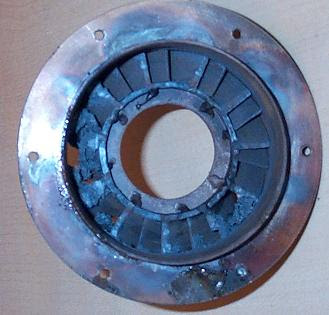After getting some advice, I decided to remake the Combustion Chamber.

The old one wasn't working properly, the gas mixture appeared too rich, with yellow flames visible at times.
So I made this one, with much smaller air-holes.
I think the theory is that the air is forced to move faster through the smaller holes, giving more turbulence and better mixing.
Anyway, it seems to work.
The flames are much bluer-whiter and the turbine seemed to have more shaft power.
I say 'seemed' because I got carried away with the throttle setting in an attempt to reach maximum speed and before I could measure anything the back end of the engine suddenly vomited a shower of flame and molten metal fragments!
Here's what's left of the NGV assembly. It appears that several of the stainless steel blades melted and exited through the turbine wheel.
Fortunately, they melted so completely that the turbine itself was undamaged (after I scraped the gobs of molten metal of it!)
That's despite the fact that it stopped so suddenly that the drive shaft (which continued to rotate) unscrewed itself completely and continued to spin.
It's going to be a few days before I finish making a new one.




